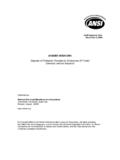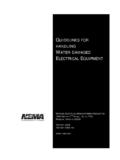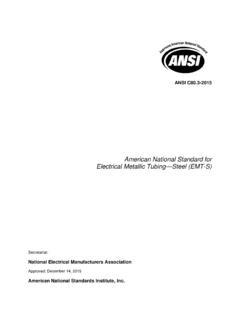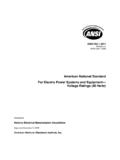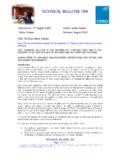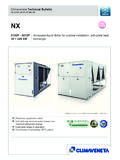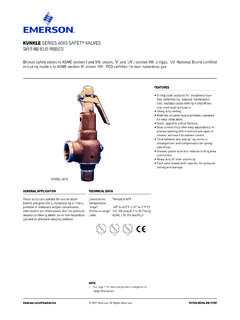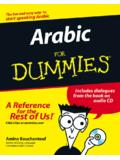Transcription of BULLETIN - NEMA
1 1 ENGINEERING DEPARTMENT BULLETIN No. 71 June 1965 Revised September 9, 2004 (Reaffirmed 12/2011) KNOCKOUT DIAMETERS AND FITTING DIMENSIONS TO ASSURE MECHANICAL AND ELECTRICAL CONTINUITY INTRODUCTION: The Joint Sections Committee on Knockout Diameters and Fitting Dimensions reviewed the existing industry practices and standards for knockout diameters and conduit fittings, and developed a table of dimensional relationships which assure no opening in the enclosure at the conduit entrance under normal conditions. Any situation which might result in an opening at the conduit entrance when a maximum size knockout and a minimum size locknut or bushing are combined with maximum off-centering of the conduit may be corrected by a minor readjustment of the conduit.
2 The Committee recommends that future designs of enclosures, which include knockouts be tooled to the nominal knockout diameters specified to allow a greater overlap for bushings or locknuts over the enclosure opening, particularly if the conduit cannot be kept centered in the opening. The Committee also reviewed the dimensions of existing conduit fittings and current installation practices, and concluded that there is no reasonable and practical way to control the maximum penetration of fittings or conduit and bushings into an enclosure when more than one conduit enters the enclosure. The solution to this problem lies with good work practices; what is reasonable penetration in one enclosure may be unacceptable in another.
3 GUIDELINES: The following dimensions have been developed by the Joint Sections Committee on Knockout Diameters and Fitting Dimensions and approved by the Codes and Standards Committee as a proposal to be considered by NEMA Sections for inclusion in existing standards publications. Distribution List: Standards and Conformity Assessment Policy Committee Codes and Standards Committee NEMA Executive Staff 2 Fig. 71-1 Metallic Bushing Figure 71-2 Nonmetallic Bushing with Locknut Inside of Enclosure Fig. 71-3 Minimum Overlap Over Nominal Knockout 3 Table 71-1A Knockout Diameters B) Conduit Size Knockout Diameter E) F) Minimum Nominal Maximum Column 1 Column 2 Column 3 Dimension K Column 4 Trade Size Metric Designator In mm in mm in mm 1/2 16 3/4 21 1 27 1-1/4 35 1-1/2 41 2 53 2-1/2 63 3 78 3-1/2 91 4 103 5 129 6 155 4 Table 71-1B COMPATIBILITY OF KNOCKOUT DIMENSIONS WITH LOCKNUTS AND BUSHINGS B)
4 Conduit Size Metallic Bushing With or Without Insulating Throat See Fig 71-1 Nonmetallic Bushing with Locknut on Inside of Enclosure See Fig 71-2 Diameter at Flange Minimum Overlap over Nominal Knockout Minimum F) Covering Diameter Of Locknut Minimum Overlap over Nominal Knockout Minimum F) Column 1 Column 5 Dim B Column 6 Dim X Column 7 Dim B Column 8 Dim X Trade Size Metric Designator in Mm in mm in mm In mm 1/2 16 .937 3/4 21 1 27 1-1/4 35 1-1/2 41 2 53 2-1/2 63 3 78 3-1/2 91 4 103 5 129 6 155 5 Table 71-1C METALLIC CONDUIT (IMC OR RIGID) DIMENSIONS FOR REFERENCE Conduit Size Major Diameter of External Thread Minimum C) Maximum D) Column 1 Column 9 Dim P Column 10 Trade Size Metric Designator in mm in mm 1/2 16 3/4 21 1 27 1-1/4 35 1-1/2 41 2 53 2-1/2 63 3 78 3-1/2 91 4 103 5 129 6 155 Notes to Tables 71-1A, 71-1B, 71-1C A)
5 Dimensional changes in Columns 3 (Dim. K), 5 (Dim. B) and/or 7 (Dim. B), and 9 (Dim. P), may cause an incompatible assembly. B) These dimensions are for knockout diameters for single or concentric types only and exclude any projection of breakout ears or tabs. C) This dimension is the nominal major diameter of the thread at El (Ref: Fig. 4-7 of NEMA Standards Publication No. FB 1) or the nominal diameter or the intermediate metal conduit (Ref: UL 6, ANSI/UL 514, UL 1242), whichever is less. D) The maximum diameter of rigid conduit (Ref: ANSI ). E) Dimensions for trade sizes of 1/2 through 1-1/4 (metric designator 16 through 35) are from Table of UL 514. Minimum dimension for larger sizes is necessary to clear the maximum diameter of the external thread ( , Col.
6 1 is greater than Col. 10). F) The stated values are calculated: the minimum overlap (Dim X) equals the minimum diameter (at flange or outer diameter of locknut) (Dim. B), minus the minimum major diameter (Dim P), divided by 2, minus the conduit clearance (Dim C); where Dim C equals the nominal knockout diameter (Dim K). The relationship is given by the following equation (refer to Figure 71-3): PKPBX 2

